Ryan Hall's Blog, page 229
August 4, 2016
Shoe of The Week: Hoka One One Clifton 3
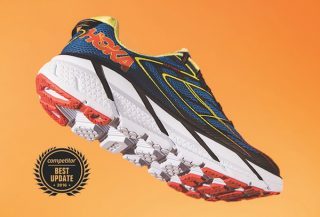
Photo: Oliver Baker
Fit/Feel/Ride: In 2014, the debut of this performance-oriented, high-mileage trainer changed how runners thought about lightweight cushioning for the road. It’s still unbelievably light and supremely cushioned, but the Clifton has evolved to be more stable and to provide a more accommodating shape in the forefoot. Although it’s a small update, it makes all the difference in the world when it comes to fit. (It’s why we gave it a Best Update award in the Fall Road Running Shoe Buyer’s Guide.) The subtle key to this shoe is the rockered shape from heel to toe, a curve that allows very efficient gait turnover. Our testers loved the cushioning and energy of this shoe on all sorts of moderate to longer runs, but most thought it had too much cushioning underfoot to be agile enough for shorter speed sessions. (It should be clear that the proprioceptive feel for the ground is understandably lacking in this shoe.) Still, several testers said they’d choose it for their next road marathon or half marathon. Also, the flat laces worked great at providing a snug but comfortable fit.
Price: $130
Weights: 8.6 oz. (men’s), 7.7 oz. (women’s)
Heel-to-Toe Offset: 5mm; 29mm (heel), 24mm (forefoot)
Info: HokaOneOne.com
RELATED: Shoe of the Week—Brooks Ghost 9
The post Shoe of The Week: Hoka One One Clifton 3 appeared first on Competitor.com.
Strava Introduces ‘Beacon’ Safety Feature for Premium Subscribers

Strava, the social network for athletes, has introduced “Beacon,” a new safety feature available now for Strava Premium subscribers. Beacon allows athletes to share their real-time location information with select safety contacts, offering peace of mind for them as well as their friends and family.
“Every athlete wants to be safe, and we felt we could help,” says Aaron Forth, chief product officer. “We’re so proud to introduce Beacon, not only because our community and their loved ones have been asking for it, but also because Beacon adds a new dimension to Strava Premium. Whether you are training regularly, commuting back and forth or heading out for the occasional workout, all types of athletes will find Beacon valuable.”
After enabling Beacon, athletes can select up to three safety contacts who will receive a text message with a unique URL when the activity begins. Safety contacts can click the URL to track the athlete on a map in real time, as well as view the athlete’s remaining battery power. Contacts do not need a Strava account to view real-time information. Beacon also saves contact settings, allowing athletes to use Beacon during future activities with one tap.
Strava’s basic online service, which allows athletes to record and socialize their athletic performances online, is free. The premium service ($59 per year or $6 per month) offers several additional features, including personalized coaching, live feedback and advanced analysis tools. Training plans by McMillan Running are also available. Beacon requires Strava v4.22.00 or later. Download Strava for iOS or Android and upgrade to Strava Premium.
RELATED: 7 Great Apps to Track Your Running Data
The post Strava Introduces ‘Beacon’ Safety Feature for Premium Subscribers appeared first on Competitor.com.
August 3, 2016
Epic Adventure: Running Colorado’s Four Pass Loop
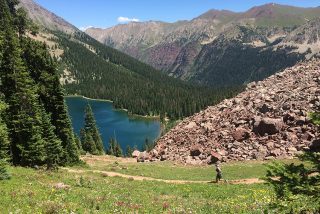
Running the Four Pass Loop near Aspen, Colo., should be on every trail runner's bucket list.

Running the Four Pass Loop near Aspen, Colo., should be on every trail runner’s bucket list.
Turquoise lakes, kaleidoscopic wildflowers, waterfalls, plush singletrack trails and endless alpine vistas. If these are qualities you seek in a mountain run, then Colorado’s Four Pass Loop (4PL), a classic adventure running linkup through the jagged Elk Mountains just south of Aspen, is one for the bucket list.
The route entails 27 miles of singletrack trails and 8,000 feet of elevation gain as it circles some of the most photographed peaks in North America. For trail runners who wish to tackle it in a day, it’s a robust but enjoyable high-altitude endurance test piece.
I first ran it solo two summers ago, and it’s so special that I had to go back again, this time joined by friend and frequent adventure partner Brian Metzler, Competitor’s editor in chief. Click through the photos below to see how our amazing day went down and check out this map of the route.
RELATED: Taking the Challenge of Running the Grand Canyon R2R2R
Photo Gallery
1 of {count}
Back to Start
View Larger Image
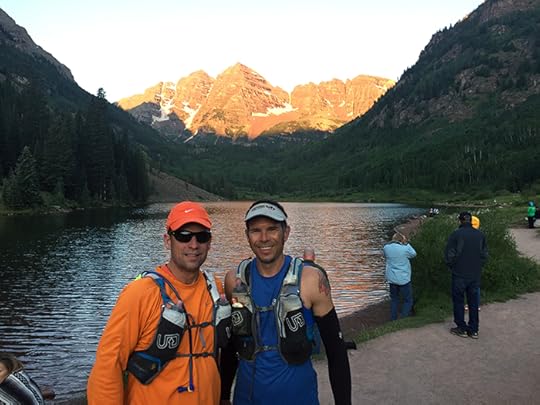
Early Morning Start
We started just after sunrise at Maroon Lake, as several nature photographers line up behind us to capture first light on the Maroon Bells. The main Maroon Bells trailhead is located 10 miles south of Aspen up Maroon Creek Road. If you're planning to drive, arrive early as the road is only open to buses from 8 a.m. to 5 p.m.
View Larger Image

Crossing Maroon Creek
Beginning with this creek crossing en route to West Maroon Pass, we couldn’t have been happier with our shoe choice. We were both rocking the new Hoka One Tor Speed 2 mid-top, which boasts maximum cushion, grippy Vibram outsoles, waterproof eVENT membrane, and stability that allows you to run right over small rocks and roots for hours. For a long day on the trail, it offered plenty of long-wearing comfort, soft cushioning, reliable traction, midfoot and high-ankle support and waterproof/breathable protection
View Larger Image
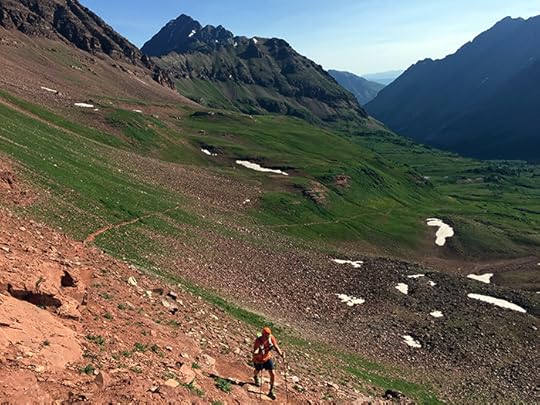
West Maroon Pass
With 3,000 feet of climbing over 7 miles, this is the biggest—but not toughest—climb of the day. We paced ourselves early and felt great.
View Larger Image
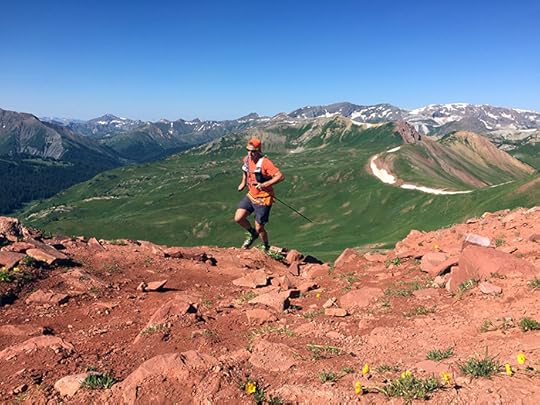
Heading Up Frigid Air Pass
Two down, two to go! This is a south-looking view of Brian punching it to the summit of Frigid Air Pass. Entranced by the explosive wildflowers surrounding pristine singetrack trails, we barely noticed the 2.5 miles and easy elevation change between West Maroon and Frigid Air passes. Off in the distance, there's a trail that leads south to Crested Butte, which is only about 20 miles away.
View Larger Image
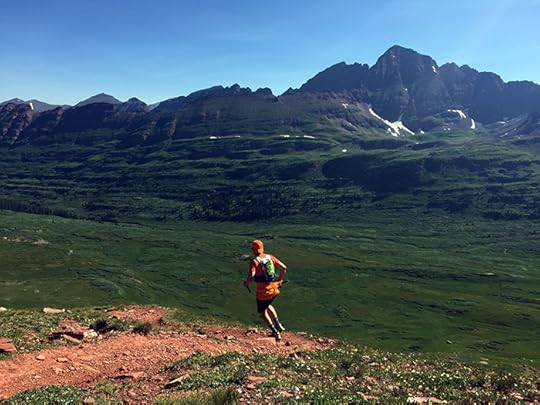
Over Frigid Air Pass
Here we’re heading off the north side of Frigid Air Pass into the verdant green Fravert Basin, with 14,163-foot Maroon Peak presiding. Though high pressure inspired confidence, alpine weather can be dangerously fickle. As insurance, I carried a practically weight-less Outdoor Research Helium II jacket, along with a Buff, some arm sleeves, and a pair of light gloves.
View Larger Image
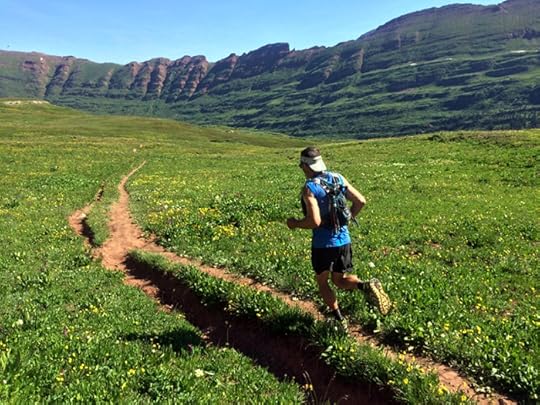
Fravert Basin
Cruising through the sublime Fravert Basin. If forced to choose, I’d call this my favorite section of 4PL. Yep…I’m gonna run the 4PL every year for as long as I can.
View Larger Image
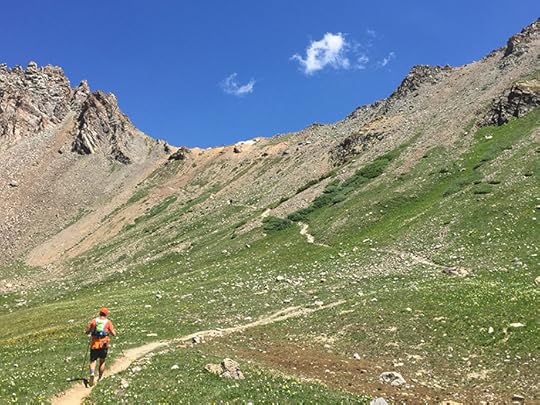
The Final Climb to Trail Rider Pass
This is the last push up Trail Rider Pass. During this climb, which delivers the steepest, most demanding sections of the route, the exertion, sun and altitude began to take a toll. I’ve learned the hard way about the importance of keeping electrolytes in balance, so I augmented Honey Stinger gels, chews, and waffles with Skratch Labs Rescue Hydration mix. With sodium levels replenished, I felt better right away.
View Larger Image
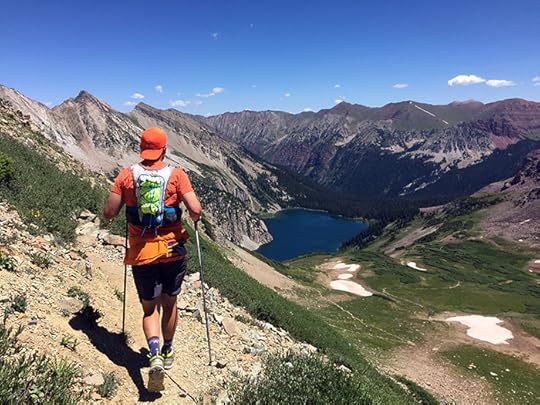
Ascent to Trail Rider Pass
Beginning the steep descent down Trail Rider Pass toward picturesque and pristine Snowmass Lake.
View Larger Image
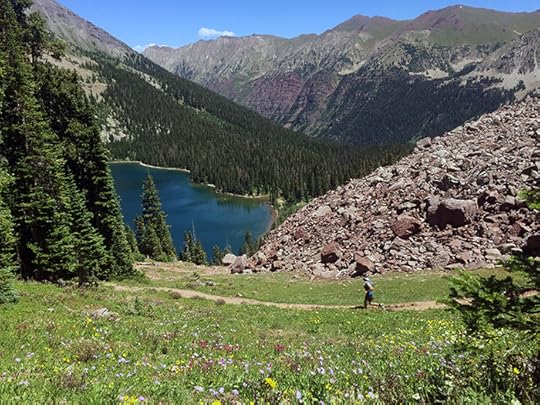
Snowmass Lake
Usage of Maroon-Bells-Snowmass Wilderness has spiked in recent years, with Four Pass Loop being a top attraction. Snowmass Lake is a particularly powerful magnet for backpackers, runners and hikers, and is in danger of being loved to death. Prevalent impact issues that pose a threat to this sensitive environment include litter, unburied human feces, and bear encounters due to improper food storage. Please treat Wilderness with the respect it deserves, and leave only your footprints behind you.
View Larger Image
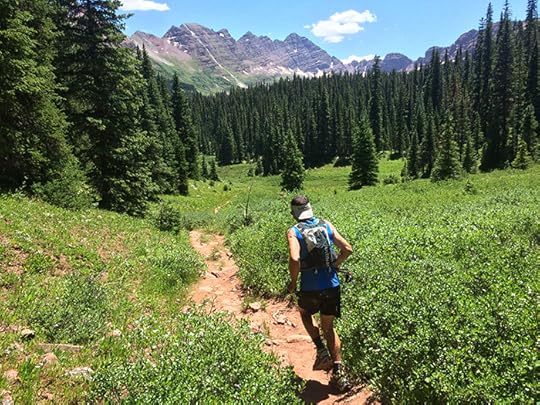
Approach to Bucksin Pass
The jagged westerly aspect of the Maroon Bells gets closer as we begin the last climb up Buckskin Pass.
View Larger Image
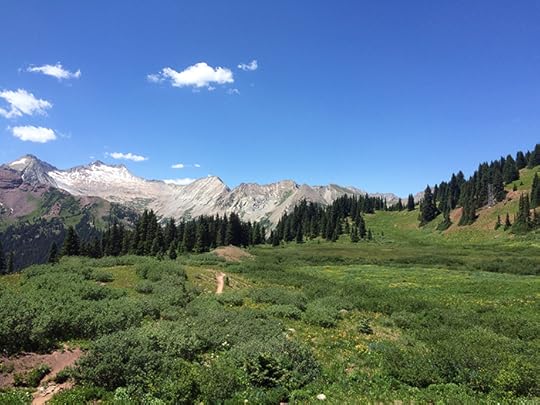
Snowmass Mountain
While ascending Buckskin Pass, we turned back to gawk at this view of Snowmass Mountain (14,098 feet).
View Larger Image
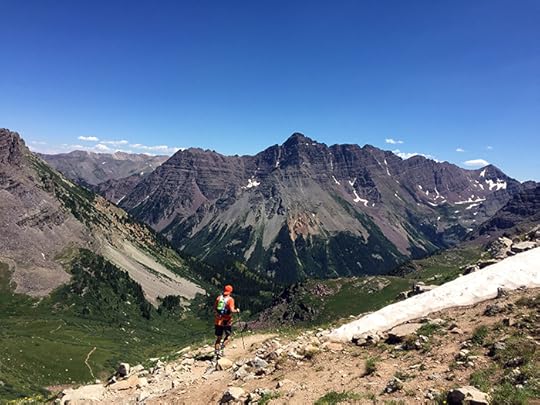
Going Over Buckskin Pass
Yeah, baby! With the majestic Pyramid Peak (14,026 feet) in the foreground, we’re home free over Buckskin Pass.
View Larger Image
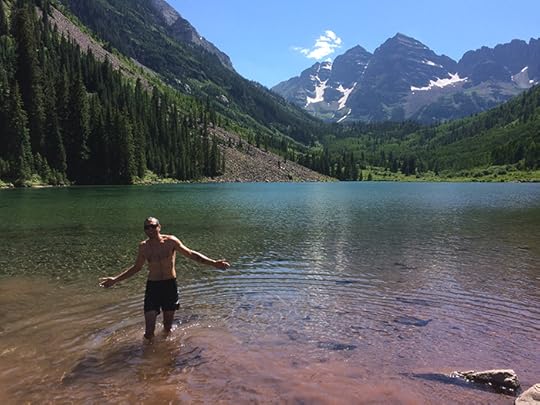
Mission Accomplished
We made it back to where we started unscathed, although the heat and fatigue certainly became a factor. We took a dip in Maroon Lake and celebrated with a cold beer. We finished in 9 hours, a much more leisurely clip than Sage Canaday’s blistering 4:27 FKT set in 2013. No matter what pace you go, it's all about enjoying the time on the trail and the scenery.
Related Galleries

Photos: 2016 U.S. Mountain Running Championships at Loon Mountain
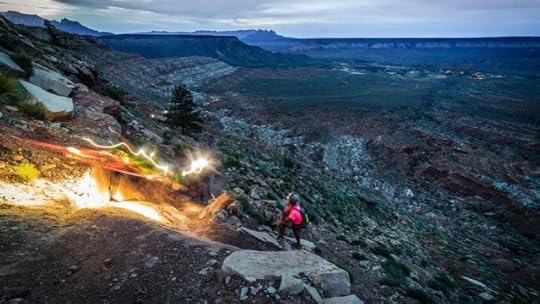
Photos: 2016 Zion 100 Miler
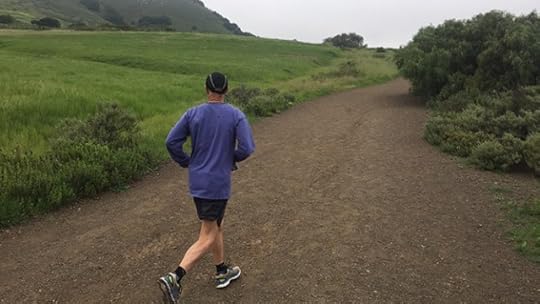
Photos: Trail Running in San Luis Obispo, California
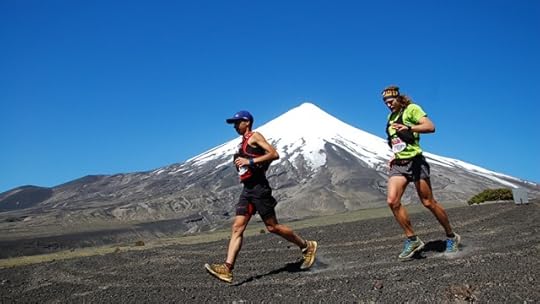
Photos: A Glimpse Inside The Volcano Ultra Trail Races in Chilean Patagonia

More Galleries
The post Epic Adventure: Running Colorado’s Four Pass Loop appeared first on Competitor.com.
Video: A Rare View of Running in the Kenyan Rift Valley
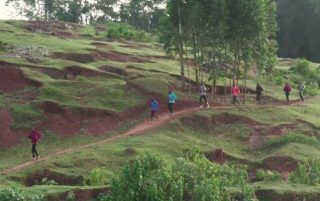
It’s widely known that Kenyans are among the fastest runners in the world. Running is an integral part of life and culture within the great Kenyan Rift Valley where countless of Olympic champions tread its grounds and train year-round. This 7-minute documentary, “Kukimbia,” by Spencer MacDonald and originally published on The Atlantic gives a rare and breathtaking tour of the valley, and immerses the viewer in the daily routines of a Kenyan runner. Athletes featured include Paul Koech, Leonard Komon, and Milcah Chemos who will be competing at the Rio Olympics.
The post Video: A Rare View of Running in the Kenyan Rift Valley appeared first on Competitor.com.
Let the Games Begin: Why You Can’t Wait to Watch the Olympics

Despite the corruption and other stories of ill repute coming out of Rio, the Summer Olympics will be an amazing spectacle to watch. Photo: PhotoRun.net
The Olympic Games are nearly upon us, and well, they could use a little good press. From accusations of government corruption, to performance-enhancing drugs to all manners of nastiness in the water at Guanabara Bay, some of the reports from host city Rio de Janeiro have been less than uplifting.
Yet, the world will soon look to Brazil in hopes of spectacle and inspiration—the qualities that have made the Games a sports juggernaut for the past half century and the impetus behind the inception of the modern Olympics in 1896. Because the Olympics deliver an amazingly diverse and fascinating program that transcends sports, with more than 10,000 athletes competing in 306 separate events, a global television audience in the hundreds of millions will certainly once again tune in to watch.
You should too, and not just for the running. The full track and field program (qualifying events begin on Aug. 12 and the men’s marathon on Aug. 21 is the Games’ last event) offers incredible displays of power, speed, agility and endurance. More medals are awarded on and inside the oval than in any other category of the Olympics.
RELATED: How to Watch Track & Field in the Rio Olympics
Even the most diehard runner would be foolish to miss the full breadth of the Olympic contests. There are just too many great stories to be enjoyed, spread over 19 days of competition. From individual contests to team sports (soccer has the most athletes playing at the same time) and the largest to the smallest (in 2012, Iceland’s athletes were the tallest, Japan’s were the shortest), the Games bring humans of every size and shape together. Just one slip or stumble and it’s a four-year wait for redemption.
But here’s how the average runner can really benefit from watching other Olympic events. Trying to improve your concentration skills so you can hit your 5K goal? Watch a bit of archery and learn about the meditation skills required to post a top score. Have you been hitting the weights to improve the strength and flexibility of your runner’s physique? Watch in awe as an Olympic lifter snaps a bar loaded with twice his body weight overhead.
For Americans who are not making the trip to Rio, the main viewing platform will be NBC, which is devoting an unprecedented number of television hours to the Games. But, as this Wired magazine story reveals, a web-savvy viewer can also find myriad online options to soak up the action—including in virtual reality.
Not by coincidence, the biggest names and marquee events will be broadcast during primetime hours. Remember, though, for every Michael Phelps, Usain Bolt or Simone Biles that appears on your screen, there are dozens of equally inspirational athletes in Rio trying to bring home the hardware. There are more opportunities to watch them go for the gold than ever before, though you might have to stay up late or get up early to catch the action. That’s OK though—you’re a runner. An athlete.
Turn it on and tune in. You live for this stuff.
RELATED: Complete 2016 Olympic Track & Field Schedule
The post Let the Games Begin: Why You Can’t Wait to Watch the Olympics appeared first on Competitor.com.
August 2, 2016
Running Around the World in 7 Days
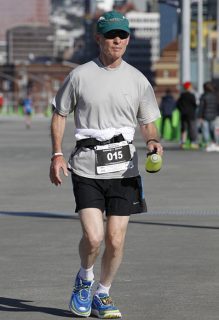
In 2015 Glen Avery ran the Wellington Marathon in New Zealand.
At 66 years old, Glen Avery plans on completing seven marathons on seven continents in seven days as a participant in the World Marathon Challenge in January 2017.
“It’s 184 miles of running, and almost 24,000 miles in the air,” Avery says. “Conditions start at 5 below zero degrees in Antarctica to the high 80s in Dubai and Australia. You can’t train for that completely. But because I’ve done ultramarathons, I’m using that kind of training as a means of training my mind. My body I’ve trained all year and have been training for years, so I think I’m pretty good in terms of that.”
For being the oldest future participant by about two decades in this absurd challenge, the recently retired Houghton College technology librarian living in the New York area sounds confident. It’s because he’s already run a marathon on each of the seven continents, twice!
The first cycle took him nine years to complete. He started with the 2002 Athens Marathon in Greece—his first marathon and first international travel with his wife, Marge. A month later they flew to Hawaii, where Avery ran the Honolulu Marathon. He finished the cycle on Christmas Day in 2011 at 4 a.m. in Thailand.
Avery finished the second round about five months ago in the Falkland Islands, off the coast of Argentina, where he befriended a group of 20 Argentinians after being stranded on the islands for an extra week due to weather. This time it only took four years.
“The first time around, I started getting into traveling and could use running a marathon or ultra as an excuse to travel somewhere,” Avery says. “Then my wife and I started thinking about where would we like to go that we have never been to before. And the first thought that goes through my mind is, ‘I wonder if they have a marathon there.’”
Avery has run races in 17 countries. Out of all of them—Ireland, Canada, England, Brazil, Spain, Peru, Philippines and Cuba to name a few—he says the 12-hour, 56-mile Comrades Marathon in South Africa was his most memorable. The most difficult was a 39-miler in Switzerland with 9,000 feet of elevation gain, ranging from freezing cold to warm temperatures.
Now Avery will be attempting his third global marathon trek, but within a much shorter timespan. However, unlike the other roughly 15 participants (based on 2015 and 2016 entries) including retired American pro marathoner Ryan Hall, he won’t be doing it in order to be the fastest or to win it. It’s just what he loves to do: travel, meet new people, and run really long distances. “I decided to challenge all the skills I know I have and all the skills I don’t know I have, put them together and do the ultimate marathon, which is seven marathons in seven days on seven continents.”
The post Running Around the World in 7 Days appeared first on Competitor.com.
The Right Way to Clean Your Running Shoes

Running shoes get dirty. But don’t let it bother you too much—look at the grime as a sign that you’re putting in good miles. But if your shoes get so dirty or smelly that you’re just dying to wash them, there are ways to clean them safely.
“Skip the washer and dryer,” says David Bond, who’s designed running shoes for adidas and K-Swiss, and is a co-founder of Ampla footwear. Bond explains that running shoes use a water-based cement to hold them together. “If you submerge them in water, like in a washing machine, or put them in the dryer, the shoe will start to disassemble.”
For similar reasons, Bond also says to steer clear of spraying your shoes with a hose, or letting them dry in the sun. “It’s just not good for the shape of the shoe,” he says. Instead, take a wet washcloth and wipe down the outside of your shoe, treating your kicks like you would your car.
Removing Mud
Ultrarunner Mike Wolfe has run some of the muddiest, muckiest terrain around. He lives and trains in Montana, where mud season, plus summer thunderstorms and long winters, mean his shoes get pretty darn dirty. And while he says “you can usually just run the dirt off” by doing more miles on a dry day, he has some tried-and-true tricks.
For one, he suggests wading in shallow water toward the end of your run to loosen and remove the mud. If there are patches of snow around, dragging your feet through the snow works, too. “Finding a sharp stick and digging dirt off the outsole like a horse and horseshoe works,” he says, “and so does letting your shoes dry out completely, then banging them together or on the ground to get the dirt off.”
Get the Stink Out
“The majority of shoes these days have Ortholite sockliners made with antimicrobial properties, which helps fight odor,” says Bond. But if your shoes start stinking for whatever reason—maybe you’ve worn them without socks, or maybe they’ve been wet too long and start smelling like mildew, or maybe they just stink—replacing the insole can help.
Otherwise, using a mild soap and a toothbrush can fight the stink (and get your shoes cleaner). “A baby wipe or some Oxyclean also works,” says Claire Wood, senior product manager of performance running footwear for New Balance. “Take the sockliners out to spray them down, and let them dry thoroughly,” she adds.
Dry Your Shoes
If you’ve cleaned your shoes by using a damp washcloth or toothbrush, or they got wet on a rainy run or in the shallow puddle you used to get off some mud, it’s important to dry them completely. Again, skip the dryer and the heat of direct sunlight.
“Take out the insoles, if you haven’t already, and stuff the shoes with newspapers,” Wood says. The newspaper helps absorb moisture. Moisture can contribute to a stink build-up, which you’re trying to prevent in the first place. Plus, the quicker your shoes dry, the quicker you can get back out running.
The post The Right Way to Clean Your Running Shoes appeared first on Competitor.com.
Coach Culpepper: What I Learned From The Olympics
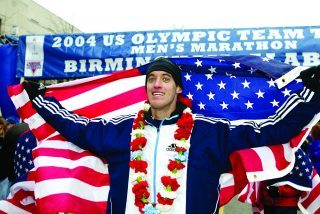
Alan Culpepper earned the chance to run in the Athens Olympics by winning the 2004 U.S. Olympic Trials Marathon. Photo: Photorun.net
I was fortunate to qualify for two Olympics: the 2000 Sydney Games, where I competed in the 10,000-meter run on the track, and in 2004 in Athens, where I ran the marathon. I had two markedly different experiences and learned lessons that I applied through the remainder of my career. While I realize the opportunity to run in the Olympics is very rare, we all share the same goal of running our best when it matters most. The key is in understanding what circumstances you perform best under, and learning how to re-create that environment.
How to use disappointment as motivation
Four days before the 10,000m in Sydney, I came down with the flu. Fever, congestion, coughing and laid up in bed was far from the ideal lead-up to racing with the best athletes in the world. Not surprisingly, I ran very poorly—so poorly that the performance bordered on humiliating. The goal with any major championship, or any goal event you’ve been training for, is always to finish feeling as if you competed to the best of your ability. Being ill, I was not able to showcase my best effort and was extremely disappointed. These types of performances usually lead to either discouragement or motivation. For myself, poor showings always lead to a higher level of motivation to set new goals and prove that I could overcome the setback. The frustration and dissatisfaction of my Sydney experience propelled my performances in subsequent seasons. I set personal bests in the several events the following year including the 10,000 and won a few national championships. Setbacks are inevitable; how we respond to disappointment is the differentiator.
The importance of a pre-race plan
In Sydney I took a more relaxed and whimsical approach to my pre-race planning. This could be largely attributed to lack of experience and ultimately not knowing what to expect. I failed to think through all the various scenarios and how best to limit the distractions and mental drains that come with unfamiliarity. I was very close to peak form physically and mentally, but I lacked a confidence in all the various logistical details that come with an event like this. The larger the event, the more complex they are logistically, and there’s an even greater need for pre-race planning. This is true for any level of athlete and those who have orchestrated a well thought-out plan always perform better. It allows them to focus more intently on the execution of their race.
The result
In Athens I did not make this mistake again. Before the event, I discussed all the various scenarios including the team training camp, sleeping arrangements, transportation, meal planning, course tour, race day logistics, etc. In the end, I was able to focus on my race, deal with fewer distractions and less uncertainty, and ultimately start my race with more confidence. This showed on race day, when I was able to complete the goal we all share of running the best we possibly can on that given day. I still look back on my 2004 Olympic marathon as one of the best races of my career.
The post Coach Culpepper: What I Learned From The Olympics appeared first on Competitor.com.
4 Amazonian Superfoods to Include in Your Diet

People in the Amazon have relied on these tropical ingredients for centuries, each of which are now becoming popular health supplements within the U.S. From energizing fats, proteins and carbohydrates to recovery-aiding nutrients and vitamins, here’s how these four superfoods from the jungle can fuel your running.
Photo Gallery
1 of {count}
Back to Start
View Larger Image

Açai
A purplish black berry similar in appearance to a grape, but with much less pulp, that grows on açai palms. The açai berry has been touted for its restorative antioxidant properties that improve blood circulation and protect healthy cells from free radicals. Runners tend to overproduce these free radicals, and that oxidative stress can lead to accelerated aging, damaged immune cells, chronic fatigue, inflammation, and muscle soreness and damage.
View Larger Image
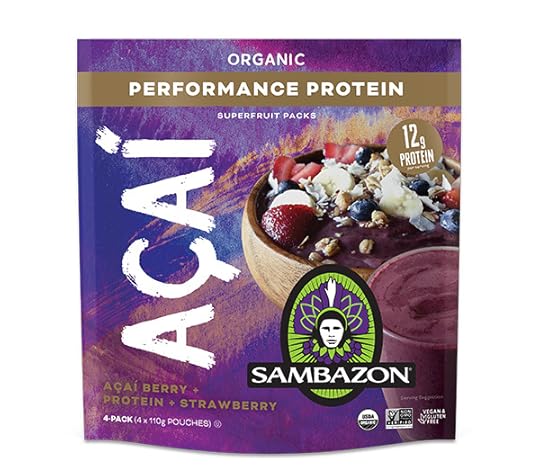
Sambazon Acai Superfruit Performance Protein Packs, $8 for a 4-pack
The açai berry's most popular form comes in açai bowls or smoothies. These performance protein packs from Sambazon contain frozen açai pulp and 12 grams of vegan protein perfect for blending into bowls topped with fruit, coconut flakes and granola or on-the-go smoothies.
View Larger Image
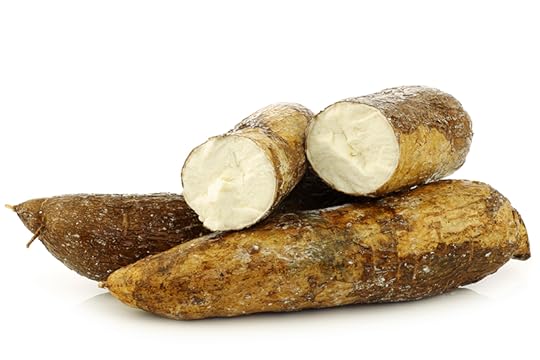
Cassava
A starch-rich tuberous root vegetable, similar to yams or potatoes, also known as tapioca when dried to a pearly extract. Cassava has nearly double the calories and carbohydrates than most potatoes. It’s ideal fuel for distance runners putting in 100-plus mileage weeks, but should be taken in moderation otherwise. They’re also a decent source of vitamin B-complexes, potassium and dietary proteins. Like most starches, its most hailed quality is being gluten-free; when converted into flour it makes a good baking alternative.
View Larger Image

Otto’s Cassava Flour, $18 for a 2-pound bag
Since cassava flour is a 1:1 substitute to wheat flours, it’s most commonly used in baking and making tapioca dishes. Otto’s Cassava Flour uses 100 percent peeled, sun-dried and then grounded cassava that avoids the acidic fermentation process most other products on the market undergo.
View Larger Image
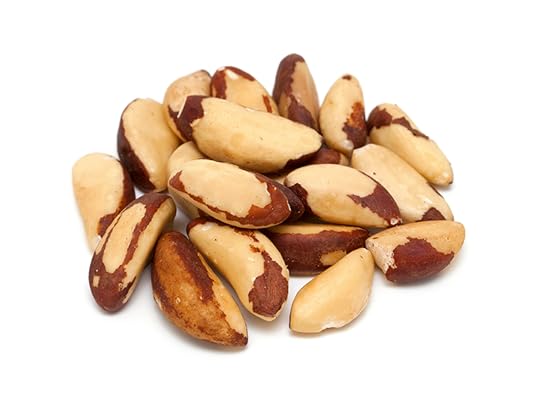
Brazil Nut
Native communities within the Amazon basin rely on the Brazil nut, which are the seeds of a large fruit from the Brazil nut tree, as a source of energy due to its high protein and fat content. The monounsaturated fatty acids help to lower LDL (“bad cholesterol”) and increase HDL (“good cholesterol”) levels in the blood—meaning they’ll reduce your risk of heart disease and other illnesses associated with high cholesterol.
View Larger Image

Nuttzo’s Power Fuel nut butter, $19 for a 16-ounce jar
Like any other nut, the Brazil nut can be eaten roasted, salted or plain raw. Throw some into trail mix or use it in nut butter such as Nuttzo’s Power Fuel nut butter . This nut butter contains seven nut and seed ingredients including organic Brazil nuts.
View Larger Image

Guayusa
A leaf grown on holly trees native to Ecuador and brewed in teas. More of a “super-leaf,” guayusa is neither green nor black tea. In fact its effects are more closely related to coffee in that it contains just as much caffeine. It’s also packed with polyphenols, the antioxidants found in wine and cacao known to prevent cancer, and chlorogenic acids known to improve cardiovascular health. Unlike green and black teas, there are no astringent-tasting tannins in guayusa; it has more of a sweet taste.
View Larger Image

Runa Energy Drink, $45.45 for a 12-pack
Guayusa loose leaf and cold-brewed teas and energy drinks are sold by RUNA. RUNA, which means “fully alive” in the language of the native Kichwa people in Ecuador, guayusa teas provide clean, natural-tasting energy with up to 120mg of caffeine in its energy drink. That’s more than an average cup of coffee of 95mg. Replace it with your pre-run coffee for a more sustaining source of energy.

More Galleries
The post 4 Amazonian Superfoods to Include in Your Diet appeared first on Competitor.com.
Get Inspired by Olympic Heptathlete Barbara Nwaba
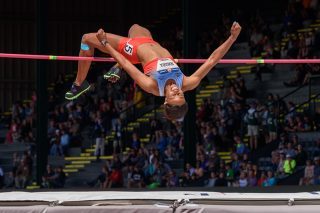
There's plenty of takeaway points you can glean from American heptathlete Barbara Nwaba, one of the world's most versatile athletes. Here she clears a high jump bar set at 6 feet, 2.75 inches en route to winning the event at the U.S. Olympic Trials in Eugene, Ore., in July. Photo: Dave Albo
Barbara Nwaba is a very busy woman. In fact, the 2105 and 2016 U.S. national champion heptathlete is so busy that she’s talking to me by phone at the same time she gets treated by her chiropractor. She’s getting tuned up before her trip to Rio de Janeiro, where she hopes to be in contention for a medal in her first Olympics.
“I get bored really easily,” jokes the 27-year-old from Santa Barbara, Calif., between chiropractic adjustments. Fortunately, that’s exactly what makes her good at heptathlon—a grueling two-day, seven-event competition that starts with the 100m hurdles, includes high jump, shot put, 200m, long jump, javelin and an arduous two-lap 800m race to cap it off. The key, Nwaba says, is to focus always on the task at hand and not to dwell on anything that’s already happened. “Whether you have a good event or a bad event, park it and move on.”
RELATED: How to Watch Track & Field at the Rio Olympics
Patient Progress
Nwaba’s heptathlon advice could also serve as decent advice for life too, and that’s particularly true when it comes to the patience needed for slow and focused progress across so many disciplines.
She was a high school hurdler when her college coach at UC Santa Barbara convinced her to try the heptathlon, even though she had never done most of the events. (Javelin is still not her favorite.) It was hard for Nwaba to believe she could ever be good. But, slowly, she learned the techniques for shot put and long jump and even javelin. She stopped worrying about the bigger picture and simply focused on improving one small thing at a time. And it worked.
“You just get better as you go,” she says.
The Seven-Day Circus
That single-minded focus is key to success within the circus of elite heptathlon. Just training for one event is a full-time job for most professional athletes. Training for seven sounded like a logistical nightmare to me. How do you make sure you’re getting enough technique work at the high jump, but also running enough to also be good at the 800m? Is it possible to ever really feel like you’re doing enough (or like you’re getting enough rest)?
Apparently, I am worrying way too much about all this. Nwaba, on the other hand, takes the chaos in stride. There is simply a schedule and she sticks to the schedule, but keeps enough flexibility to make changes when necessary.
In the fall, Nwaba does strength work in the gym and builds up a foundation of running—though she rarely runs long, just about 30 minutes or so at a time. That turns into more explosive efforts in the winter to prepare for high jump and long jump. And then, once the season is underway, it’s shotput and 200m repeats on the grass on Mondays; hurdles, high jump, sprints and the weight room on Tuesdays; active recovery Wednesdays; a hard long jump and sprint session on Thursdays, followed by the weight room again; javelin technique and 800m track sessions on Friday; weight room on Saturday (depending on how she’s recovering from the week’s work); and then on Sundays we rest.
Sleep and Eat, and Sleep and Eat Some More
If that sounds exhausting, it’s because it is.
“I love sleep. That’s my favorite thing to do,” Nwaba says. She also gets a massage every 2 to 3 weeks, and foam rolls every day before and after practice. And she (unsurprisingly) eats a diet of healthy fats, lean protein, and lots of fruits and vegetables. Although she’s not super strict, she says. Of course, her standard of “not super strict” just means that she only allows herself one cheat day per week at most. She doesn’t worry too much about calories, as long as it’s not cookies, because she needs to stay fueled between workouts and especially between the two days of competition.
It’s hard to eat during meets and you don’t have enough time for a big lunch between events anyway, so Nwaba makes sure to have a hearty breakfast and then snack on bananas, trail mix, and possibly a sandwich—and other things that are easier to keep down.
“I drink a lot of Pedialyte,” she says.
Eating isn’t the only thing that’s hard during meets. Sleeping that night in between the two days of competition is also tough. That’s when you have to put everything out of your head again, watch a movie, and relax—so that when the time comes you can focus on the one task at hand.
Eye on the Prize—But Not Too Much
When we talked, Nwaba was not packed yet for the trip to Rio, but she wasn’t too worried about that either. She planned to throw everything in a bag and fly down this week with her coach Josh Priester, Priester’s parents, her boyfriend, her mom, and the all-important chiropractor. She’ll walk in the Opening Ceremony on Aug. 5 (which will count as her workout for the day) and she’ll see as much as she can around the Athlete Village. Then, if she’s lucky, she’ll have an outside shot at a medal. (She’s ranked sixth in the world heading into the Games.) Not that she’ll necessarily know during the competition.
Heptathlon is scored based on a points system of benchmarks. Achieve higher or lower than the standard in any event and you’ll get more or less points, per a complicated formula.
But, despite having competed in these events dozens of times, Nwaba says she doesn’t have the exact points formula memorized. “We don’t have a calculator,” she jokes. She knows her personal bests in each event and how she generally expects to perform. “I let my coach worry about everything else,” she says. And he’ll tell her, as it gets closer to the final 800m, what she needs to do or how she’s stacking up. That’s all she needs to know.
Grounded in Reality
In college it’s relatively straightforward to be a student-athlete. You just show up where you’re supposed to be when you’re supposed to be there. After college, though, as she started training with the newly formed Santa Barbara Track Club, which Priester founded to help post-collegiate heptathletes and decathletes, Nwaba struggled to find balance in her life. Suddenly, it was all track all the time; there weren’t any classes or other places to be. And she found she needed something else to round things out.
“You need to have other things to pull you back,” she says, to ground you in the real world.
So she goes to church, hangs out with her friends and boyfriend, and works with the Santa Barbara Youth Track Club. That way when it’s not time for heptathlon, she doesn’t worry about heptathlon. And when it is time for heptathlon, she’s able to focus solely and intently on the task at hand, and then move on to the next task and the next one after that—until eventually those tasks add up to a national championship.
Like I said: heptathlon advice makes for good life advice too.
The post Get Inspired by Olympic Heptathlete Barbara Nwaba appeared first on Competitor.com.
Ryan Hall's Blog
- Ryan Hall's profile
- 21 followers



